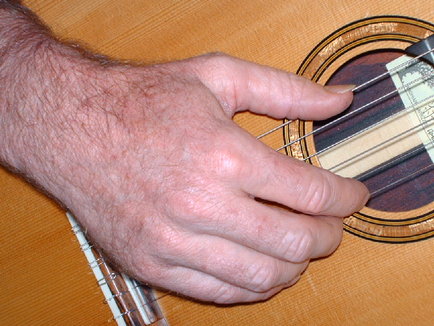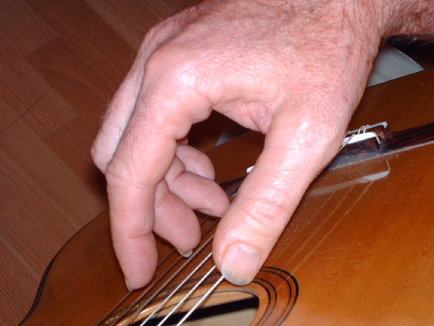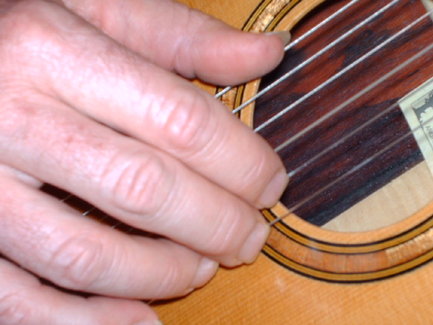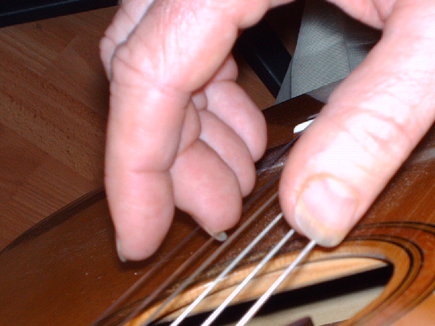Rest Stroke Alternation
You may wish to review Introduction To The Right Hand before continuing with this lesson.
The Rest Stroke
The Rest Stroke (Apoyando) is so named because the right hand finger which executes the stroke ends up resting on the next lower string. To prepare for the Rest Stroke, place "p" on the 6th string (this will act as a physical point of reference for the right hand) and "i" on the 1st string. "P" should be slightly in advance (to your left) of "i".
The Rest Stroke
The Rest Stroke (Apoyando) is so named because the right hand finger which executes the stroke ends up resting on the next lower string. To prepare for the Rest Stroke, place "p" on the 6th string (this will act as a physical point of reference for the right hand) and "i" on the 1st string. "P" should be slightly in advance (to your left) of "i".
Once the Rest Stroke has been executed, "i" will end up on the 2nd string, but this is not accomplished by aiming "i" at the second string. That would create too shallow a Rest Stroke. Instead, am "i" at the label of the guitar which is inside the soundhole. You won't be able to see it, but imagine where it is. As you begin the Rest Stroke with "i", allow the tip segment of the finger to relax so it may pass easily through the 1st string. Practice the Rest Stroke with both the "i" and "m" fingers.
Alternation
One of the most basic principles in right hand technique is Alternation which allows the player to always have a right hand finger ready to play. This is accomplished by returning a finger to a position of readiness at the same time another finger is playing. Alternation may take place between any two right hand fingers, but most typically occurs between "i" and "m".
To prepare for alternation, play a Rest Stroke with "i'" on the 1st string. Next, play a Rest Stroke with "m" on the
1st string. At the same time "m" is playing, return "i" to the first string. This will shut off the note which was just played by "m". While this doesn't sound very good, it will teach you to move the fingers simultaneously.
Alternation
One of the most basic principles in right hand technique is Alternation which allows the player to always have a right hand finger ready to play. This is accomplished by returning a finger to a position of readiness at the same time another finger is playing. Alternation may take place between any two right hand fingers, but most typically occurs between "i" and "m".
To prepare for alternation, play a Rest Stroke with "i'" on the 1st string. Next, play a Rest Stroke with "m" on the
1st string. At the same time "m" is playing, return "i" to the first string. This will shut off the note which was just played by "m". While this doesn't sound very good, it will teach you to move the fingers simultaneously.
Now, play "i" and return "m" to the 1st string in the same manner. You are now back to where you started.
Once you are comfortable with "i" and "m" alternation, there is one small adjustment which will make the notes legato (connected). Instead of bringing the returning finger to the 1st string (which shuts it off) return it to a point is space OVER the 1st string.
You are still returning the finger while the other finger is playing. You are just not shutting off the first
string. Try to keep the returning finger as close as possible to the first string. You will now bring the finger to the string while executing the Rest Stroke as opposed to returning.
For more information on alternation with "i" and "m", please see String Crossing
string. Try to keep the returning finger as close as possible to the first string. You will now bring the finger to the string while executing the Rest Stroke as opposed to returning.
For more information on alternation with "i" and "m", please see String Crossing
Copyright © 2011 by Thomas Coffey All Rights Reserved International Copyright Secured



